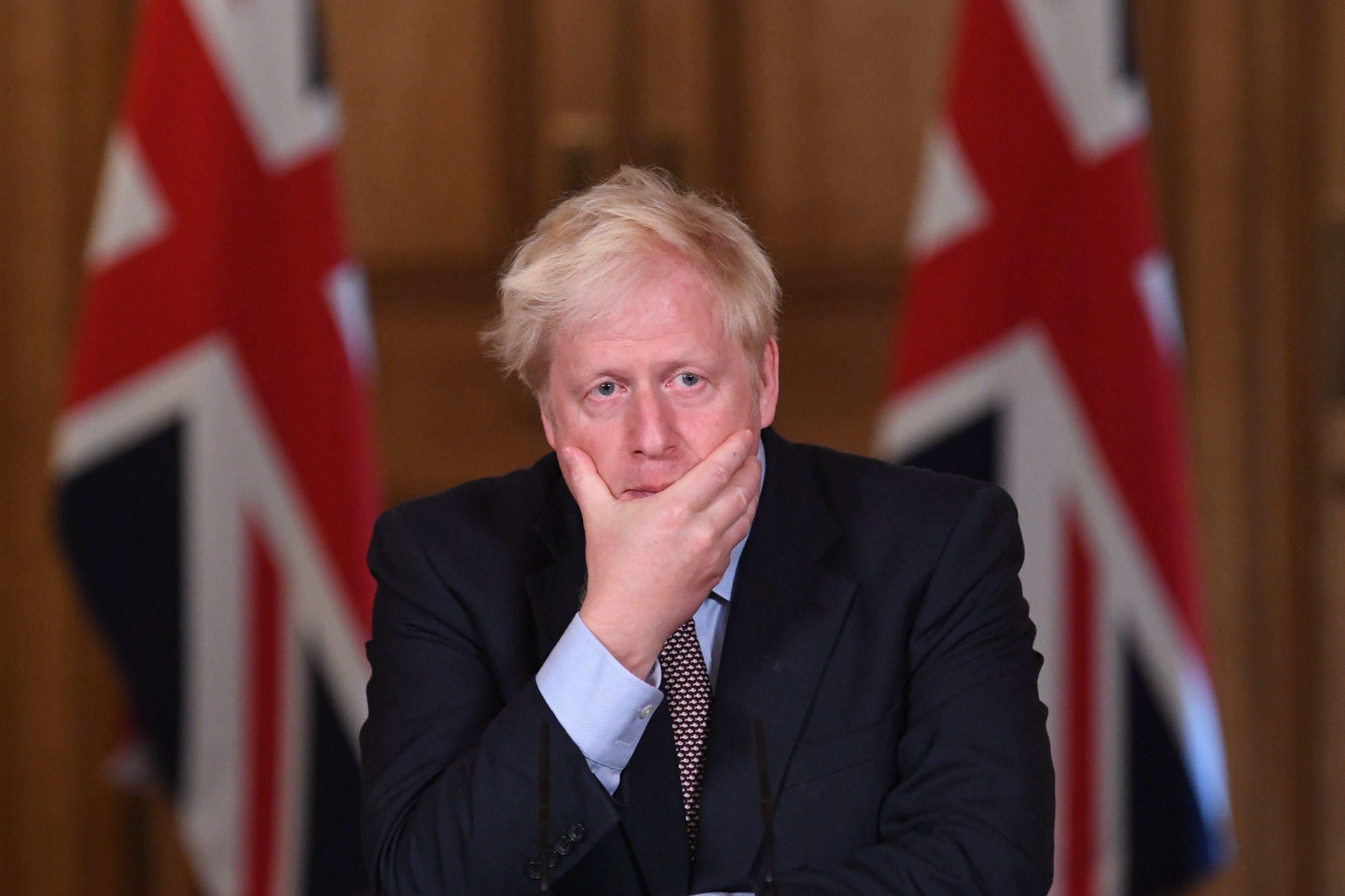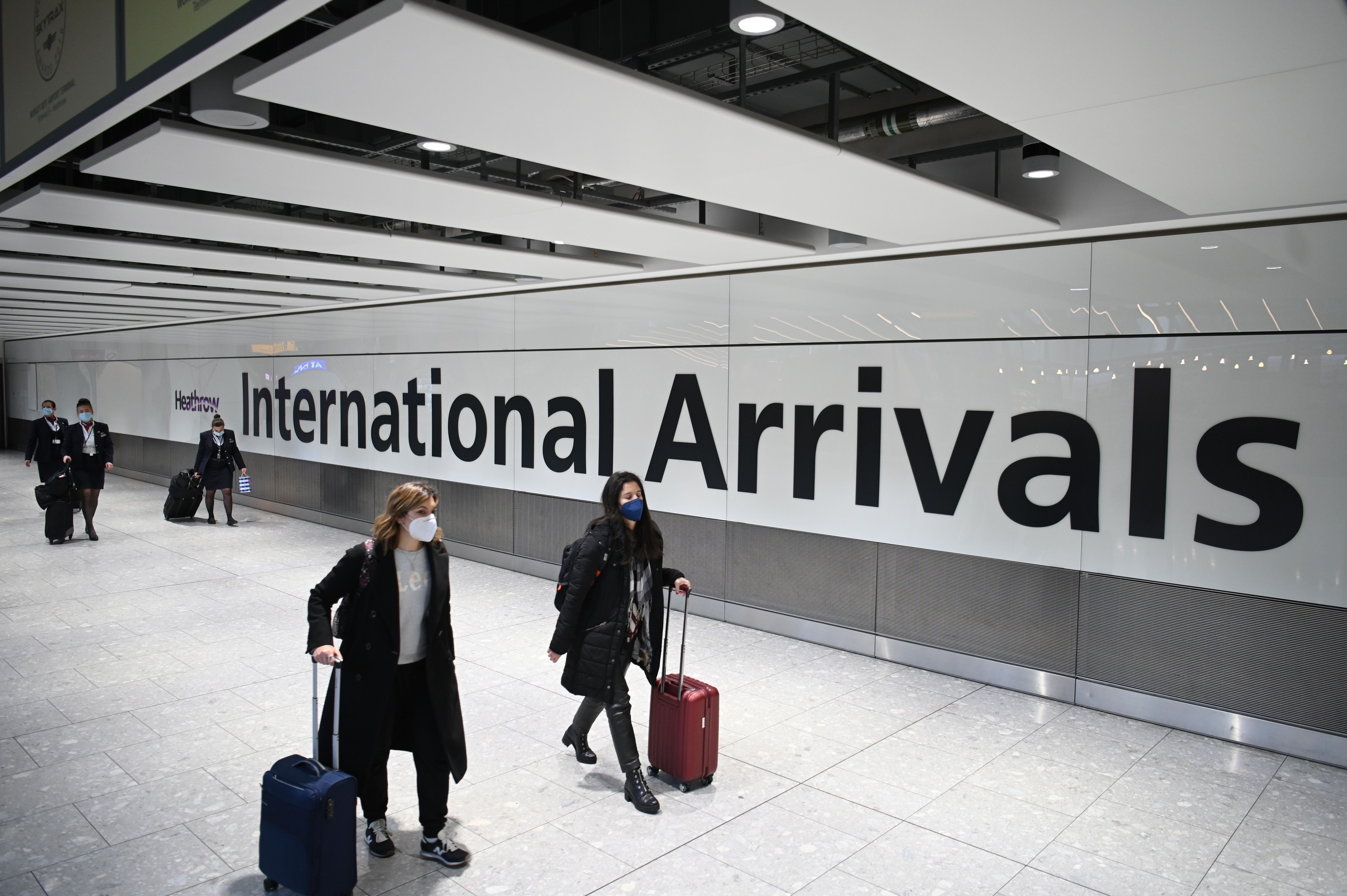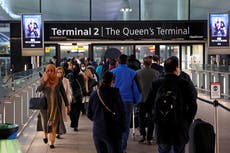‘This was absolutely avoidable’: How the UK lost 100,000 lives to Covid-19
A catalogue of costly errors, the refusal to heed scientific advice at crucial pinch-points and the absence of any real strategy set the UK on a collision course with tragedy, writes Samuel Lovett


More than 100,000 people in the UK have now died from Covid-19 – a heart-wrenching, incomprehensible figure that many experts and scientists believe to be rooted in the failures of a “reckless" government that has overseen one of the largest “avoidable” losses of lives in generations.
Few ever envisioned the UK reaching such a grim milestone, yet nearly 12 months on from the beginning of the pandemic – and despite countless opportunities and warnings to take corrective action – the country stands alone with the highest daily death rate in the world.
More than a quarter of all UK deaths have been reported in the last month alone, the culmination of the government’s failed tier system, pre-Christmas mixing and the emergence of the new coronavirus variant, critics say. Against this backdrop, the NHS has found itself overwhelmed by a surge of hospitalisations previously unseen throughout the pandemic.
But the reality is that such statistics barely scratch the surface of suffering that has paralysed the UK over the course of the crisis. Each lost life was a mother, a father, a child, a friend, a neighbour, a colleague – someone known and loved by another.
As is the case with every other nation, the pandemic will leave its mark on the UK in the years and decades to come. None will emerge from this dark chapter unscathed.
Prime minister Boris Johnson said he was “truly sorry” for every life lost and has pledged to launch an inquiry into Britain’s handling of the pandemic, but insisted on Tuesday evening that “we truly did everything that we could, and continue to do everything that we can, to minimise [the] loss of life and to minimise suffering.”
However, for many of those scientists who either advised the government or watched on helplessly from the sidelines as their warnings went unheeded, there is no excusing the realities of the past year and the scale of mortality that has swept across the UK.
“This was absolutely avoidable,” Professor Stephen Griffin, a virologist at the University of Leeds, tells The Independent. “You can't be reactive in a pandemic, you have to be proactive and act ahead of the curve. We’ve repeatedly failed in this sense.
“The fact we've had three lockdowns is the ultimate expression of failure, I’m afraid, because you should not need to have more than one.”
There is some sympathy within the scientific community towards the UK’s vulnerable position heading into the pandemic: an international travel hub with countless connections throughout the world; a globalised capital that helped to seed infections in the population; a creaking, underfunded public health system already on the brink.
“Britain was always going to be hit hard,” Mark Woolhouse, a professor of infectious disease epidemiology at the University of Edinburgh, tells The Independent.
“Once an infectious disease is widely seeded, that usually sets the course for what follows. The UK was at a disadvantage in this respect – particularly London – as we are so well connected globally that we are always in the frontline for something like this.”
Dr Tom Wingfield, a senior clinical lecturer at the Liverpool School of Tropical Medicine, says that some acknowledgement must also be given to our older population. “This will have an impact on hospitalisations and mortality rates, as opposed to, say, Nigeria where the median age is about 20,” he tells The Independent.
But the response that followed the arrival of Covid-19 set the UK on a dark path from which we have never really departed.
The first wave
All experts are more or less in consensus that the government acted far too late in implementing the national lockdown, having ignored the warnings of many of its own advisers – despite later insistences of “following the science”.
This delay allowed the virus to creep into all pockets of the population – young and old, rural and urban, rich and poor. “The epidemic was seeded significantly in spring that by the time we locked down we were overwhelmed,” says Professor Griffin.
In other words, when the historic announcement came on 23 March for all Britons to stay at home – an unimaginable, unprecedented diktat in peacetime – the damage had already been done. The trajectory of the first wave was set.
Research from Imperial College London later showed that up to 26,800 deaths could have been prevented had lockdown come just one week earlier.
The government’s mishandling of the care sector has also been flagged as a major pitfall that served to heighten the severity of the first peak. Linda Bauld, a professor of public health at the University of Edinburgh, criticises the “failure to look at Italy and recognise that older people were more vulnerable and therefore care homes needed to have a protective bubble around them”.
Instead, in an attempt to prepare England’s hospitals for the rising Covid surge, elderly in-patients were freely discharged to care homes without being tested. On 17 March, NHS England and NHS Improvement wrote to trusts telling them to “expand critical care capacity to the maximum” by freeing up beds. The policy lasted until 15 April.
A report published by National Audit Office on 12 June later confirmed that 25,000 untested people were moved from hospitals into care homes between mid-March and mid-April – the height of the spring pandemic – potentially accelerating the spread of the virus among one of the UK’s most vulnerable groups.
One scientific adviser to the government told The Independent that it was apparent from the outcomes of elderly passengers on the stricken Diamond Cruise ship, docked in Yokohama throughout February 2020, that old people were at risk.
"There was a lot of concern about age and institutions early on, so why on earth wasn’t it acted on? The narrative coming from government was that we're all in this together, the virus doesn’t discriminate, we're all at risk,” says the adviser, who asked to remain anonymous. “This was understandably done to justify locking us down.
“But that clouded discussion. I think there was a lot of people trying to spin this to get people to cooperate with lockdown. My concern is that distracted from where the threat really was, and the threat was in care homes, but people weren't talking about that.”
‘They didn’t fix the roof while the sun was shining’
The next significant misstep came in the decision to lift the first lockdown measures too early, scientists say.
“The lockdown did bring cases right down, but the problem is that the virus wasn’t completely gone,” Professor Julian Tang, a virologist at Leicester University, tells The Independent. “If you relax all the restrictions as they did in summer, with Eat Out to Help Out and allowing domestic and international, you're going to let the virus grow – and it did.”
On the same day that pubs, restaurants, hairdressers and cinemas were reopened on 4 July, 400 new cases were recorded across the UK – though the real figure is likely to have been much higher given the prevalence of asymptomatic infections and, crucially, the fact Britain’s contact tracing system was in its infancy.
Indeed, figures published by the Office for National Statistics published later that month indicated that 4,200 daily infections were still occurring in England – at a time when indoor gatherings were allowed, the two-metre social distancing had been dropped and employees permitted to return to the office.
“It was inevitable we were going to have a second wave with those number of cases,” says Dr Wingfield – a concern that will have been communicated by the likes of Professor Chris Whitty and Professor Sir Patrick Vallance in early summer, only to be ignored by those eager to “save the economy”.
That initial dichotomy – between the economy and the health of the nation – was false and dangerous, adds Dr Wingfield. “There's lots of analyses that show that those countries that have done best financially are the ones who got the virus under control. It’s not a bipolar argument: the economy versus the virus. It’s the same thing. You control virus, you save the economy.”
In the face of mounting pressure to reopen society and arrest the UK’s economical slide, the argument for prolonging lockdown restrictions, especially when cases appeared to be so low, was inevitably a tough one to make. And in this instance, it was the scientists who lost the debate.
This may not have been so devastating had Britain emerged from lockdown well-equipped to keep on top of those infections that were simmering away in the summer. But the ill-fated Test and Trace programme was not up to the job.
Outsourced to the private sector, the system was – and still is – too slow and cumbersome in processing tests, informing people of their results and reaching the close contacts of Covid-19 cases. The prime minister promised last June to provide a 24-hour turnaround for all in-person tests by the end of the month – but even now that pledge remains unfulfilled.
The fact we've had three lockdowns is the ultimate expression of failure
While it has improved to pick up thousands of daily symptomatic cases, says Professor Tang, it has not done enough to detect the “background” asymptomatic infections that have been spreading continually throughout the pandemic. “All we’ve seen is the tip of the iceberg,” he adds.
“They didn’t fix the roof while the sun was shining,” Professor Griffin says. “Especially in the north, infections continued to be at a high level and that's why it came back in the autumn so quickly. It really doesn't take much to flip the epidemic from a static phase into exponential growth.”
He says this process was accelerated by the importation of new infections from abroad. Whereas countries like Singapore, Hong Kong, Australia and South Korea introduced strict quarantine rules for travellers as early as March 2020, such measures have been conspicuous by their absence in the UK. Only now, almost 12 months on, is the government moving to address this.
“Mixing caused by schools and universities returning compounded the issue, as did the encouragement for everyone to get back to work in August,” adds Professor Griffin. "This not only led to a more rapid resurgence per se, but also provided a fertile breeding ground in which the new, more transmissible variant arose and continued to spread.”
Non-compliant pockets of the population certainly played a role in fuelling this resurgence, but the government’s mixed messaging and own transgressions – as in the case of the Dominic Cummings scandal – didn’t help matters, says Professor Bauld.
In June 2020, a YouGov poll found that Britons were following the lockdown rules less strictly than before – with a third of those citing the actions of the former PM adviser as a factor.
“You've heard ministers pointing the finger at students and young people, unhelpful messaging, poor communication with the public, and the breaches – those were things not handled well by the government and they eroded trust and compliance,” says Professor Bauld.
The second wave
By the time autumn arrived, it was obvious that cases and deaths were rising in the UK. But once again the government dismissed the warnings of its own Scientific Advisory Group for Emergencies (Sage), which called for a lockdown in September to halt the mounting second wave.
Professor Whitty was even mocked by some for suggesting that the UK could reach 200 deaths a day by mid-November – a grim forecast that eventually materialised and forced No 10 to take action in the form of a “useless” circuit-breaker that arrived far too late to make a difference.
“I can’t think of a single implementation of a lockdown or measure that they haven't kept under review for weeks and weeks and then eventually done it when it gets to crisis point,” says Professor Griffin.

“The decision to ignore Sage in September pressing for a short, sharp lockdown was a massive mistake – at the time we were in the early phase of exponential growth and the variant was also geographically limited. The parties responsible for preventing this now have blood on their hands.”
The new variant – which is thought to be more transmissible and more deadly – has certainly fuelled the current crisis, but epidemiologists and virologists are confident that the foundations for the second wave were firmly set during the tiered-restrictions approach, which kept cases bubbling away at a threshold level before the fatal release of the holiday period.
“Post November lockdown, London and Kent in tier 2, non-essential shops opening for Christmas shopping – that's a wildfire, even without the new variant,” says Professor Tang. “You’re asking for trouble.
“All this bouncing backwards between lockdown, relaxation, lockdown, relaxation – we're in the third one now – it just fuels the epidemic. You're always chasing the virus, and if you're chasing it, you'll never catch it.”
A second scientific adviser to the government, who asked not to be named, told The Independent that the British variant has been used as “the perfect out” by the government, allowing ministers to shift blame away from their own failed policies and the “reckless” run-up to Christmas.
For Gabriel Scally, a professor of public health and member of Independent Sage, there has been “no strategic plan” from day one, with the government blindly lurching from disaster to disaster.
“Ask the UK government where is its strategy,” he tells The Independent. “I’m quite sure one of the reasons we don't have a plan is because that would involve having to say what we're going to do, when we're going to do it and what the effect would be – something our government is not capable of."
The consequences of such indecision, procrastination and the abdication of responsibility at key crisis points have proved fatal, he adds.
Many have argued that the UK is not unique in its experience of the second wave, that other European countries like Germany – which was previously praised for its handling of the pandemic – have now succumbed to the inevitable, tragic realities of this crisis.
“But the first thing to say is that just because other places have gone the same way, it doesn’t mean it's right,” says Professor Scally. The failures of others should not absolve Britain of its own sins, he adds, arguing that Europe as a whole had the opportunities to learn from its initial mistakes at the start of the pandemic, as well as the examples set by south Asia.
Nonetheless, for Britain at least, the writing has been on the wall for many weeks – yet confirmation of 100,000 deaths is no easier to accept, especially when so much could have been done to avoid reaching this tragic milestone.
The ongoing progress of the vaccine roll-out – one of the few successes that the government can happily point to – offers cause for hope, the scientists say, but the emergence of new variants and the challenges this will bring reaffirms the need to adopt a strategy that seeks total suppression and control of the virus.
“The lesson must now be learned that dealing with Covid and national recovery are inextricably linked, and we must maintain vigilance whilst doing so over the longer term,” says Professor Griffin. “We have vaccines, but we must protect these precious tools by crushing cases and introducing the systems that ought to have been established last year for effective track, trace and isolate.
“The country is enduring a national tragedy, pegged back only by the valiance of NHS staff and other key workers. It is now critical that policy is enacted for the greater good, and for the longer term.”
Join our commenting forum
Join thought-provoking conversations, follow other Independent readers and see their replies
Comments





Bookmark popover
Removed from bookmarks